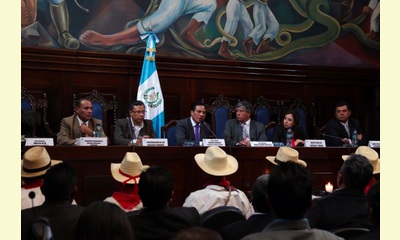|
|
Mining interests in Guatemala challenged by indigenous direct democracy
un article par Jeff Abbott, Waging Nonviolence (abridged)
. . . On the chilly morning of October 26 in the highland
municipality of Santa Maria Chiquimula about 125 miles from
Guatemala City, residents came out to participate in a
community vote deciding whether or not they would resist the
exploitation of natural resources. 
Community leaders of Santa Maria Chiquimula deliver the results of the consulta to a panel of government ministers from the Congressional Commission on Indigenous Affairs, the Ministry of Energy and Mining, and the Ministry of Natural Resources on November 4. (WNV/Jeff Abbott)
click on photo to enlarge
The consultation was held in response to the Guatemalan
government’s issuing of a permit to a Guatemalan subsidiary of
the Italian mining firm Enel for the exploration of geothermic
energy within the municipality. As in past cases, the government
failed to consult the indigenous people prior to issuing the
permit.
The practice of the community consultation represents a form of
indigenous direct democracy, a “non-Western form of social
organization,” according to said Nim Sanik, of the Kaqchikel
Maya branch of the CPO in the department of Chimaltenango. It
also serves as an important tool to the indigenous communities
as they organize to defend their lives and territory.
According to Sanik, the process of the community consultation
comes from the Kiche Mayan holy book the “Popol Vuh.” In a
consulta, every resident within a community over the age of
seven has a vote and a part in the decision making process for
the community. The large consultas can take months to plan to
ensure that everyone is equally informed about what the vote is
on. In the end, the results represent the consensus of the
community. . .
Communities have increasingly returned to the consulta to
express their disapproval of mining and extractive projects in
their territories. The consultation held in Santa Maria Chiquimula
is the 73rd consultation held since 2005 within the Mayan
communities of Guatemala. In each case, the communities have
voted overwhelming against the mega-projects in their
territories. For residents, it is yes to life, and no to mining.
Back in Santa Maria Chiquimula, by the end of the day, the
40,000 residents overwhelmingly declared their resistance to
mining operations within their communities, with over 39,000
people voting against the exploitation of natural resources in the
area. From young to old, community members expressed a deep
understanding of what the mining operations would mean for
their livelihoods and environment.
“We vote no for our children,” said Maria, a resident of Santa
Maria Chiquimula. “We’ve read about the negative health
impacts from the mining operations in the department of San
Marcos, and environmental effects of other projects. We don’t
want to see those consequences in our community. That is why
we are here to vote no to mining near Santa Maria Chiquimula.”
On November 4, the community leaders of the 18 communities
of Santa Maria Chiquimula delivered the official results of the
consulta to governmental ministries, including members of the
congressional commission on indigenous peoples, the minister
of mining and energy, and the minister of natural resources.
“The people demonstrated their rejection of these types of
projects,” said Jose Carlos Carrillas, the spokesman of the
communities. “Because we believe that [this type of]
development to our communities only provokes exploitation of
the mediums of life, the division of the people, and the increase
of social and economic inequality.”
|








|
DISCUSSION
Question(s) liée(s) à cet article:
Indigenous peoples, Are they the true guardians of nature?
* * * * *
Commentaire le plus récent:
This discussion question applies to the following articles:
Indígenas del Cauca: “Somos pueblos de cultura de paz”
Colombia: The Indigenous of Cauca: "We are a people with a culture of peace"
Unidos, Jamas Seremos Vencidos: La Victoria de de Guatemala En Contra de Monsanto
United, We Will Never Be Defeated: Guatemala’s Victory Over Monsanto
Confederación Campesina del Perú presente en marcha de Cumbre de Pueblos
People's Summit in Peru: “The Earth is burning, let´s change the system!”
Canada: Kinder Morgan leaves Burnaby Mountain in win for pipeline protesters
Los indígenas de Brasil consiguen una victoria territorial a escala nacional
Brazilian Indians secure nationwide land victory
Mining interests in Guatemala challenged by indigenous direct democracy
Mayan People’s Movement Defeats Monsanto Law in Guatemala
Terrace Farming – an Ancient Indigenous Model for Food Security
Indigenous Elders Send Stern Message to UN Paris Delegates: Preventing 2°C Is Not Nearly Enough
On remote Philippine island, female forest rangers are a force to be reckoned with
USA: Standoff at Standing Rock: Even Attack Dogs Can’t Stop the Native American Resistance
Le Congrès de l’UICN stimule les droits des peuples autochtones
El Congreso de la UICN refuerza el apoyo a los derechos de los pueblos indígenas
IUCN Congress boosts support for Indigenous peoples’ rights
USA: Update from Standing Rock
Colombia: When indigenous knowledge heals and prevents the wounds of war
16 Days of Activism: Meet Anne Marie Sam, Canada
16 Days of Activism: Meet Bertha Zúñiga Cáceres, Honduras
For more recent articles, click here

|
|









